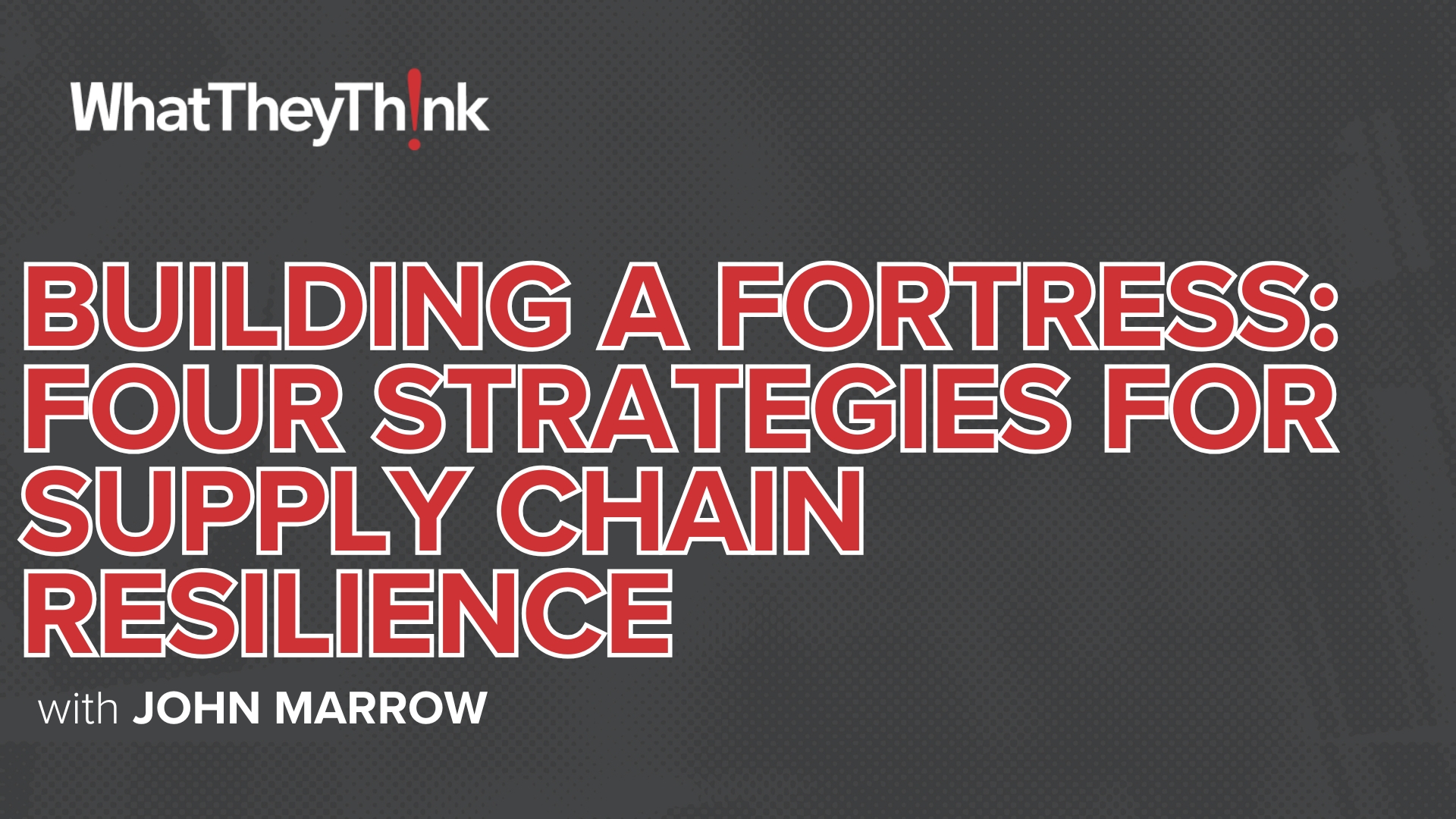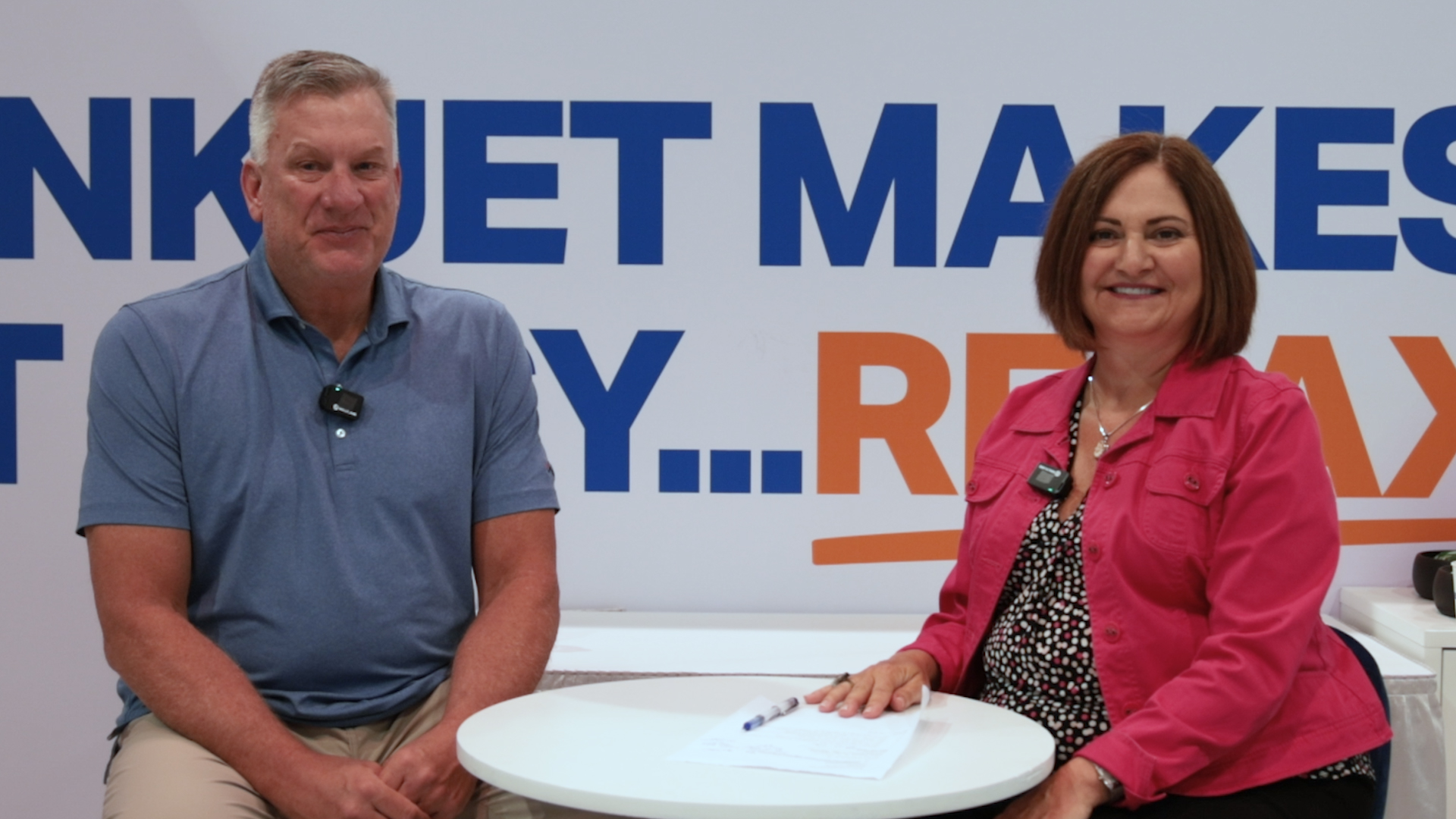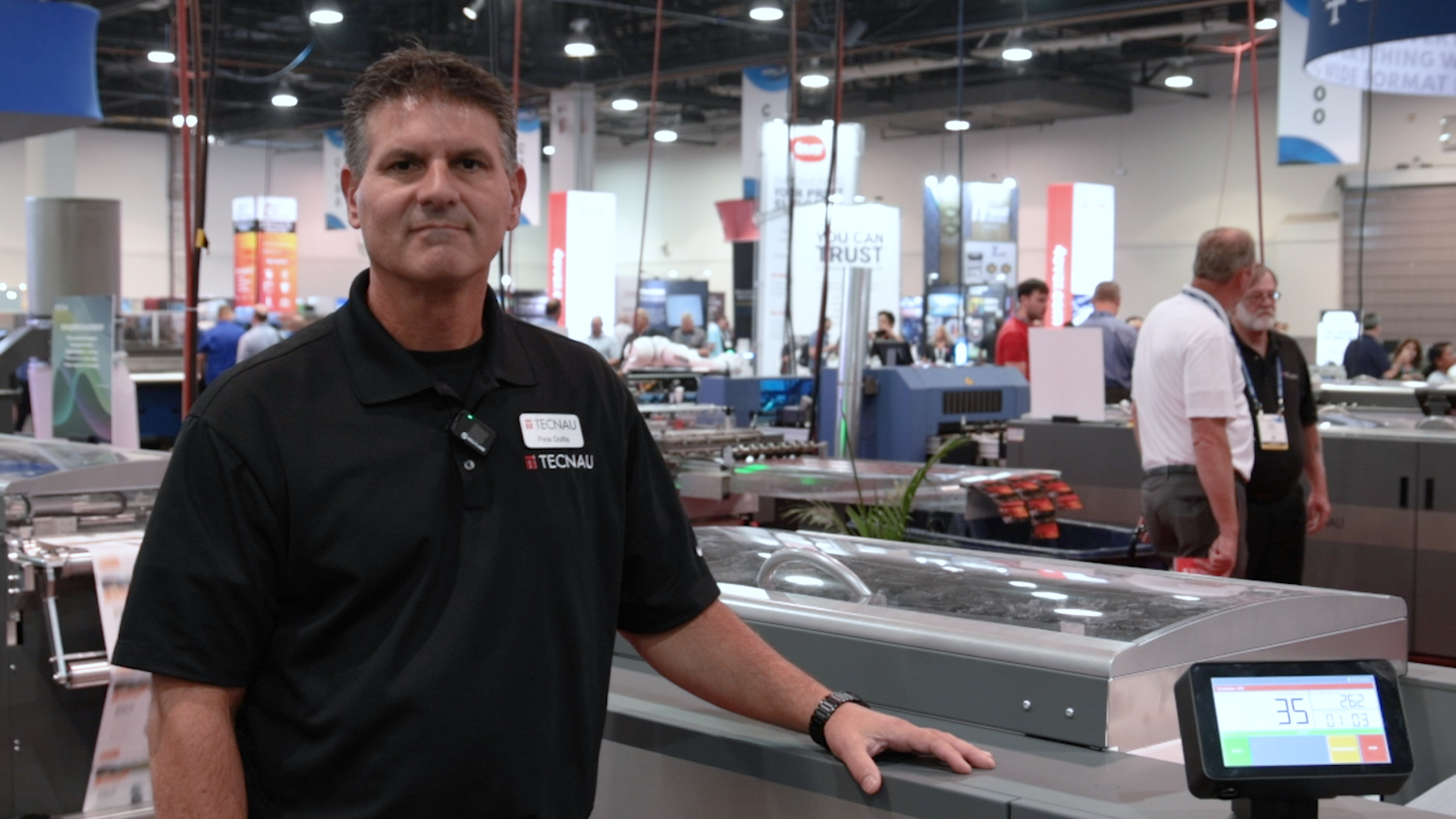Commentary & Analysis
Displaying 1551-1650 of thousands of articles
Insight You Need. Analysis You Trust.
Get the trusted insights you need to understand our evolving industry and emerging trends. Become a Premium Member.
Printing in Motion: European Print Imports and Exports
Print is being traded across borders and the European Union is making trade a lot easier. However, printing on demand, shorter runs, and streamlining supply chains gave rise to more local print. This trend is illustrated in the print import and export data.
Waiting and Maintaining: APTech Looks Forward to Gradual Return to In-Person Events in 2022
APTech President Thayer Long looks ahead to some of the events the association has planned for 2022.
An Imaging Company at Heart, SCREEN Is Building Quite a Production Inkjet Portfolio
The roots of SCREEN are in imaging, dating back to its founding in 1868. The company has leveraged that expertise to create a significant imaging powerhouse which includes industry leading equipment for the production of displays, printed circuit boards, and semiconductors. They also continue to maintain a significant role in the production of printing equipment including high performance inkjet presses for commercial and packaging.
Cotton: The Myths vs. Reality
In today’s world, we are inundated with misinformation and disinformation, and it is a constant daily battle to separate the wheat from the chaff, the truth from fake news. This is not limited to politics and healthcare. It’s also a factor in how the fashion industry—in cotton in particular—is portrayed. This article is a summary of a recent report by Transformers Foundation highlighting common myths about cotton. We recommend reading the full report and/or listening to a recent Supima webinar for the entire story.
Good Help Is Getting Harder to Find—and Keep: Print Industries Affiliates’ Latest Wage & Benefits Survey
Last month, Print Industries Affiliates hosted a webinar that presented the results of their annual printing industry Wages & Benefits Survey. This article provides some of the top-level findings, some of the short- and long-term implications of today’s employment situation, and strategies for coping with these new challenges.
All Other Converted Paper Product Manufacturing Employment—2010–2019
According to County Business Patterns, in 2010, there were 16,147 employees in 322299 (All Other Converted Paper Product Manufacturing establishments). This NAICS category bounced up and down over the course of the 2010s, ending with 15,177 employees in 2019. In macro news: Yesterday was Q4 GDP Day!
Around the Web: Graphene Galore! Blood Book. Sayonara, SATs. Salacious Solving. Bad Bedding. Suspense Sting. Top Tales. Dairy Devices. Compromised Cars. Robot Restaurant. Retro Runners.
Graphene-Info updates all its graphene market reports. Saddam Hussein’s “Blood Qur’an.” The SATs to go all-digital in 2024. Sweary and lewd versions of Wordle. Due your research before naming bedroom furniture products. Where did the “three notes of suspense” originate? A new book looks at Haruki Murakami’s T-shirt collection. Here we go: “wearables for cows.” A teen hacker gained remote access to Teslas around the world. Inside the Beijing Olympic Village cafeteria. Sneakers designed like old VHS tapes. All that and more in WhatTheyThink’s weekly miscellany.
Digital Production Printing: Selling Value in a Changing Industry
The COVID-19 pandemic created numerous challenges for the digital production printing market, including a decline in demand for print services and reduced investments in new production technology. This article cites recent forecast data from Keypoint Intelligence to explore key dynamics, challenges, and opportunities within this market.
Meet Textile Designer Lucy Swann and Discover Her Unique Creative Journey and Fashion Designs
As part of our continuing “meet the designer” series, compliments of textiles expert and WhatTheyThink contributor Debbie McKeegan, we introduce you to Lucy Swann, who has been designing beautiful surface patterns for the fashion industry for many years. She talks about her journey, how the industry has changed over the years, and her diversification efforts.
EcoPrint’s Content Marketing Is a Model of Authenticity
Clients are increasingly looking for vendors who “walk the walk” when it comes to sustainability. A look at EcoPrint, a printer committed to environmentally responsible services, as an example of how one shop does this well.
Self-Service Resistance in the Print Industry
Self-service is a strategic move. It takes leadership. The status quo is a powerful resistance machine which should not be underestimated.
European Print Industry Snapshot: Turkey
In this bimonthly series, WhatTheyThink is presenting the state of the printing industry in different European countries based on the latest monthly production numbers. This week, we take an updated look at the printing industry in Turkey.
Top Three Sales Mistakes to Avoid for 2022
The coming year will be one of rebuilding for everyone in your supply chain, including your most regular customers. They may be taking time to look carefully at all their relationships and their budgets, so you need to be visible to remain in consideration as they update their plans. Pat McGrew offers some tips for ensuring that your most loyal customers stay that way.
Interruptions vs. Opportunities: Know the Difference in Order to Make the Most of Your Day
There’s a maxim in the military which states that “no plan survives first contact with the enemy.” The practical application of that is simply that you plan based on what you know now, and then change your plan based on what you learn later. Dave Fellman explains how, If your priorities change, your plan must change.
Opportunities for Signs and Display Graphics in a Changing World of Retail
Much has been written about the Great Resignation and how worker shortages are affecting many businesses, a situation exacerbated by the pandemic. The retail industry is one that has clearly been heavily affected, leading to an increase in cashier-less checkout to help these businesses stay viable. This is a dramatic trend that also offers interesting opportunities for sign and display graphics businesses.
November Shipments: Reversion to the Mean
November 2021 printing shipments came in at $6.99 billion, down from $7.29 billion in October, and the first month that shipments dropped since early summer. Year to date, January-to-November shipments are $75.56 billion, only a bit off 2020’s January-to-November number of $76.36. If we have a really good December, 2021 could come in slightly above 2020.
Around the Web: Conquering Corrosion. Spent Signage. Talking Tech. Shambling Shelves. Periodic Poetry. Gone Games. Mechanical Masterpieces. Dish Delight.
Graphene-based anti-corrosion primer applied in the UK. Reverse-engineering Wordle. Las Vegas’s Neon Boneyard is a sign-based history of the city. What technology will invade our lives in 2022? Useful robots are simply self-driving shelves. A periodic table of haiku. What happened to Atari? Mechanical versions of classic paintings make art interactive. A useful feature of Starlink’s satellite dishes has an unforeseen consequence. All that and more in WhatTheyThink’s New Year’s miscellany.
Investing in HP Technology and Design to Expand into the Contract Furnishing Marketplace—We Talk with Mallion and Knowles
Digital textile printing is starting to gain steam in the contract furnishing marketplace! Find out how this development is benefiting Mallion & Knowles! Our thanks to textiles expert Debbie McKeegan for sharing this story.
Survey Says! Wide-Format in 2022
Every year round about this time, as we are going through the data from our annual Business Outlook Survey for the forthcoming Printing Outlook report, Richard Romano breaks out some wide-format-specific data to see what trends we can quantitatively gauge—and, specifically, what new application areas look the most promising.
Do the New Features of USPS Informed Delivery Really Make It Better?
The USPS continues to add expanded features to its Informed Delivery service, but based on the USPS’s own year-over-year customer satisfaction data, are these new features actually creating a better user experience?
Remove the Pain of Peak Production with HP Site Flow
Printers often experience the pain of peak—that time when capacity is at its limit, and even minor issues become significant. This article, written and sponsored by HP, looks at HP Site Flow, a software platform that automates processes from beginning to end, while providing tools to effectively manage the production floor and track the work to meet business goals.
How to Work Better with Print Software Technical Support
Using a software support desk is not anyone’s favorite activity. You have more control than you think over your ability to get what you need via your software vendors support desks.
EFI Reggiani Update: Adele Genoni of EFI Reggiani Talks About the Latest New Products to Hit the Market
Cary Sherburne recently spoke with Adele Genoni, senior vice president and general manager at EFI Reggiani, to get the latest information on what the company has been up to. Despite the pandemic, it doesn’t seem that R&D efforts have slowed down, with three new products announced in just the past few months.
Even Vacant Storefronts Sell: Redefining “Window Shopping”
Retailers across the world are transforming merchandise into artwork and creating eye-catching installations to drive traffic. Even though retailers may not occupy the specific storefront, there is still high foot traffic in the area and significant value in the brand real estate of a prime storefront regardless. SpeedPro explains how.
Will 2022 Be the Year of Consumer-Level Graphene Products?
Graphene, a much-touted miracle material, was only discovered in 2004. Since then, it has permeated many different industries with products and solutions that deliver improved performance or new and innovative capabilities. Now, just a short time after its discovery, it’s beginning to make its way into consumer-level products. Is there some graphene in your future? Let’s take a look!
Europe: Looking Back at 2021 and Forward to 2022
2021 was not quite what we expected, with paper shortages, transport issues, and cost increases disrupting the industry. European section editor Ralf Schlözer offers some lessons learned by the European printing industry and how to take advantage of them as we move into 2022.
Sanitary Paper Product Manufacturing Employment—2010–2019
According to County Business Patterns, in 2010, there were 19,221 employees in NAICS 322291 (Sanitary Paper Product Manufacturing establishments). This NAICS category bounced up and down over the course of the 2010s, ending with 19,593 employees in 2019. In macro news: CPI increased 0.5% in December.
Around the Web: Toaster Tech. Car Color. Tongue Texting. Dynamic Dumbbells. Pointless Purloining. Malicious Meters. Face Fitbit. Snow Solution. Troubling Tie-In.
A graphene-based toaster. A BMW covered with E Ink panels can change color at the push of a button. A “smart retainer” for tongue-based text messaging. Alexa-based smart dumbbells can adjust weights via voice command. “The Spine Collector” scams book editors for manuscript copies of forthcoming books, for seemingly no reason whatsoever. QR code-based parking meter scams. An electronic mask can detect leaks. A liquid based bubble clock. How did people clear roads before the snowplow? Walmart’s special “Pain Box” DVD edition of “Dune.” All that and more in WhatTheyThink’s Wordle-winning miscellany.
Talent and Culture as a Competitive Advantage
In this article Wayne Lynn presents the case for gaining competitive advantage through leadership development, helping employees meet their needs, and helping employees develop into better behavioral matches to high performers in their chosen jobs. Adopting this approach will, over time, strengthen the talent base of the business and foster a performance oriented culture.
Artificial Intelligence: Defining an Often-Misused Term
Artificial intelligence (AI) is much more than just a buzzword—it is currently available technology that is poised to transform much of our world, including the printing industry. This article defines this often-misused term and explains how AI differs from more traditional software programs.
The African Print Company Invests in Digital Textile Print for Absolute Supply Chain Control
Choosing to purchase their own machinery and not to outsource the manufacture of their products will give the husband-and-wife team at The African Print Company absolute control of their supply chain as they gear up the business, removing the requirement for keeping inventory on hand. And importantly, giving them the freedom to listen to their consumers and create the designs and products that their loyal customers love. They intend to implement customized manufacture and on-demand production from day one.
Why Invest in a Landa Digital Press? The View from Hudson Printing
Paul Hudson, CEO of Hudson Printing (Salt Lake City), shares his rationale for investing in a Landa S10P—why now, why the Landa, and how he expects it to impact his business.
Software’s Role in Helping Your Business Through Labor Challenges
Business processes controlled via trusted software systems are the best defense against the ever-tightening labor market.
The Industry Has Been Humming Along: The Label and Packaging Year in Review
There may not have been many live events this year to showcase the latest trends in label and packaging, but hardware manufacturers and software developers have been busy, and the industry has been humming along. All of this under the backdrop of shifting consumer preferences and supply chain challenges. David Zwang takes a look.
European Print Industry Snapshot: Bulgaria
In this bimonthly series, WhatTheyThink is presenting the state of the printing industry in different European countries based on the latest monthly production numbers. This week, we take an updated look at the printing industry in Bulgaria.
Top Three Software Sales Strategies for 2022
We were hoping that 2021 would bring stability and the end of lockdowns and quarantines. While we had some respite mid-year, we’re beginning 2022 with similar challenges. The good news for software sellers is that there is a continuing market for solutions to automate, optimize, and streamline at every step of the workflow. Contributor Pat McGrew offers three software sales strategies to kick off 2022.
Automation Will Power Your New Year
For your business to grow in 2022, you will need an intelligent infrastructure that allows work to move from sale to delivery with the least amount of friction. This article, written and sponsored by Kodak, tells you how to build a strategic plan for automation.
A Fresh Look at the Dye-Sublimation Opportunity
Back in 2019, we pointed out the opportunity presented by adding dye-sublimation printing to the mix as a diversification strategy. A great deal has happened since then, not the least of which is the continuing impact of the pandemic. But one thing that has not changed is the opportunity this technology offers. Read on!
The Target Report: GPA Global Emerges as Packaging Consolidator—December 2021 M&A Activity
Southern California Graphics Sells to GPA, CJK Acquires Again; and more…
Preliminary 2021 Business Conditions: Help Ruin This Chart!
We are sifting through the preliminary data from our 2021 Print Outlook Survey, and so far we have found that 17% of print businesses reported that revenues in 2021 increased more than 25% over 2020, and a further one-third (32%) saw revenues up 10–25%. But our survey is still open, so here is your chance to wreck this chart.
Around the Web: Public Property. Compelling Covers. Required Reading. Pre-PARC. Lego Lettering. Graphene Galore. Clever Clicker. Tongue TV. Fast Fitness. Visual Visage. Piscine Pilots.
Winnie the Pooh is ours now! The best book covers of 2021. What was the best book of the past 125 years? A history of the graphical user interface. All the latest textile-based graphene developments. Samsung’s new TV remote can harvest energy from your router’s radio waves. Sony’s new Bravia Cam allows you to control your TV via gestures. A lickable TV screen to sample televised tastes. McDonald’s in China is installing exercise bikes. A display, app, and platform for displaying digital facial expressions on masks. Fish can now drive cars. All that and more in WhatTheyThink’s New Year’s miscellany.
Let’s Try This Again: Wide Format 2022—Seven Things to Pay Attention to
Almost against all odds, here we are in 2022, and it’s hard not to get the sense that this is our third attempt at starting 2020, building on the successes of 2019 before things went south. As we head into the new year, here are some of the topics Wide Format section editor Richard Romano has been following as they relate to wide-format printing—and, specifically, the market for wide-format printing.
A Guide to Eco-Friendly, Sustainable Fabric and Textile Printing—Print Customers Are Increasingly Requesting Greener Materials
There has been significant focus on improving sustainability in the textiles and apparel industry, and that concern for the planet is also affecting what customers are demanding in signs & display graphics, especially looking for more sustainable soft signage. What type of textile printing is greenest, and what can be done to reduce waste? These are just two of the topics addressed in this article provided by Ella Faulkner of Soyang Europe, compliments of Texinel.
HBR Study Finds 28% Lift in Sales and 600% ROI by Adding Print Catalogs
In a large-scale field study conducted by Harvard Business Review, a luxury e-commerce retailer found that by adding print catalogs, it increased sales by 28% and inquiries by 77%. It also yielded a direct ROI of 600%.
Accessible Publishing: A Valued Skill for Graphic Communicators
The last century has been a time of sweeping change for mass communication methods, and the capabilities of graphic communication firms have expanded to include non-print services such as website design and email campaign development in addition to the conversion of printed documents to the Portable Document Format (PDF), web forms, or interactive media. Hal Hinderliter explains how this list of capabilities is poised to change again, as awareness increases regarding the need for all graphic communication to be made accessible to audiences with physical or cognitive limitations.
Automation Starts with Your Print MIS/ERP
Automation is about finding recurring patterns and then taking them out of the hands of humans and into the realm of software so that repetitive tasks can be done programmatically—and “programmatically” automating anything in your business will inevitably involve your Print MIS.
Reanimating the Customer Experience: Take Radical Ownership of Outcomes
The ultimate goal of customer experience management (CXM) is to establish greater customer stability and loyalty resulting in predictable, sustainable company growth. In every customer relationship there is a time when promises made must become promises kept. Preston Herrin explains how your entire team should be acutely focused on correctly establishing, measuring, and delivering on the customers’ expectations.
Color, Your Brand, and Display Graphics: How Your Clients Perceive You Through Color
In today’s world of digital and mixed analog technologies, it can be difficult to get consistent color from different platforms. Marty Davis, President of Alder Color Solutions, explains the importance of ensuring color consistency across small- and wide-format graphics.
Heidelberg: Solidly Positioned for Growth
As the print market has evolved, Heidelberg, like all other analog and digital press manufacturers, has had to pivot to address the new market demands. For a while, their transition had been a bit rocky, but they seem to have stabilized and are now growing with an impressive line of products with more to come.
Labor Pains: The Challenge of Attracting Young Talent to the Printing Industry
Although it’s not a new problem, the labor shortage in the graphic arts industry is becoming more pressing with many industries rallying for talent—and the print industry not necessarily being seen as very attractive. A lack of new staff to fill required roles is already affecting the competitiveness of many printing companies across Europe. European section editor Ralf Schlözer look at one Millennial and Gen Z employee recruitment project underway in Europe and the lessons it can teach globally.
drupa 2021 Essentials of Print: The Digitization of Packaging
Digital packaging printing allows brands to make content decisions closer to the consumer, helping them to provide more than just the traditional containment and protection functions of the pack, with information and promotion. Digital print and finishing of packaging can provide a wider range of functions beyond analogue capabilities, which is why it is growing so quickly. Smithers’ Sean Smyth looks at the current state of digital packaging and where it’s heading.
What’s the Deal with Denim?
We all love our jeans, but consumers are increasingly becoming aware of the massive environmental impact of the denim dyeing process—chemistry, water usage, potential pollution of water sources, and so on. But there are encouraging developments underway in the world of more sustainable denim. We explore a few of them here.
October Shipments: Still On the Rise
October 2021 printing shipments came in at $7.23 billion, up from September’s $6.99 billion. This is the third month in a row in which shipments increased. Year to date, January-to-October shipments are $68.21 billion, a bit off 2020’s January-to-October number of $69.03. Unless November and December are higher than expected, 2021 will come in slightly below 2020.
Frank’s Time Bandits: 80 Years of Printing’s Past, Present, and Future
As the calendar brings us to the start of another year, Frank Romano reflects on the past in terms of printing achievements...as well as how science fiction predicted the future.
Around the Web: Locked Letters. Coffee Creativity. Clever Clip. Terrific Toaster. Neat Knife. Graphic Glasses. Lego Largesse? Ornithological Oddballs. Strategic Syrup. Gingerbread Ginmill.
Mary, Queen of Scots: champion paper folder. “Coffee spill art.” Redesigning the binder clip. The smartest toaster was invented in 1949. An Internet-enabled cutting system for printers. A monocle/eyewear system for display graphics. Is it really better to invest in Lego’s than gold? The future of the swag bag? Birds aren’t real! Taping Canada’s strategic maple syrup reserves. The future of work from home? Miller High Life’s gingerbread dive bar. All that and more in WhatTheyThink’s weekly miscellany.
Simple Steps for Factoring SEO into Your Marketing Strategy
Search engine optimization—more commonly known as SEO—is a great way to spread the word about your business and its offerings. This article provides an excerpt of a conversation Keypoint Intelligence Consulting Editor Christine Dunne had with SEO Specialist Jeanne Visser, who shares some simple steps that print companies can take to improve the SEO of their websites and blogs.
The Best in British Hospitality Design
Want to find out what constitutes the Best in British Hospitality Product Design? Textiles expert and WhatTheyThink contributor Debbie McKeegan is anxious to share! She interviews the team at this year's award winner, The Monkey Puzzle Tree. Cool name. Even cooler designs!
A Folding Carton Converter Brewing Beer?
Printing and packaging companies are always looking for unique ways to expand and grow their businesses. While printers may have historically had a reputation for “tipping a few beers,” not every printer can be a brewer. However, this one is!
Textiles Year in Review: There Were Challenges and Successes
Cary Sherburne looks back at some of the notable new products and trends that the textile and apparel industry saw in 2021—from a growing emphasis on digital printing, new inks (especially pigment-based), and the reshoring of apparel production.
Landa Digital Press Update: Crossover Points, Installed Base, and the Value of Being Anti-Fragile
Miss the “Landa Nanographic Printing in the Market” webinar on November 3? Here is a recap of Landa’s portion of the presentation, giving an update on its expansion, its installed base of users, and what it’s learned about the crossover points with offset.
Measuring What Matters to Drive Optimal Behavior
The default approach to working is to just show up and respond to inputs. But what’s the non-default approach to work? Goal setting, which is more important than ever because we’re all drowning in our inputs. Prioritization is critical and goals help us prioritize.
Your Business: Looking Back and Looking Forward
As we come to the end of the year, Pat McGrew encourages us to reflect on the choices made over the past year and set goals for the coming year. Think about how to evaluate what we have experienced and make a practical plan for 2022.
Waste Circularity in Labels and Packaging: Fixing a Broken Recycling System
Recycling is broken, and we need processes that can handle waste instead of shifting responsibility for handling waste back onto consumers and producers, which will not solve the problem.
Graphic Communications Leadership Institute (GCLI) Completes First Full Year to Rave Reviews
As the Graphic Communications Leadership Institute (GCLI) wrapped up its first year of operation, we spoke with three participants to better understand the value they are getting from this three-year program. We also spoke with Francis McMahon of Canon Solutions America, who hosted this year’s final session.
The Year in Review: Finishing Is In It to Win It
It has been a wild year of highs and lows and unique pressures, but the print finishing category met the challenge and pushed forward with lots of new offerings and opportunities. Trish Witkowski looks at some of the highlights.
Grossman Marketing: A Case Study in Successful Business Transformation
How many companies have been able to successfully transform their businesses multiple times over a century of continuous operation? Not that many. That’s why the Grossman Marketing Group’s story is so interesting!
Products in Motion: European Print Imports and Exports
Differing labor rates, scales of operations, and specialization contribute to a busy trade in print products among European countries. This article, by European section editor Ralf Schlözer, provides an overview of the types of print products crossing borders, as well as trends that have developed over the last five years.
Other Converted Paper Product Manufacturing Employment—2010–2019
According to County Business Patterns, in 2010, there were 35,368 employees in NAICS 32229 (Other Converted Paper Product Manufacturing establishments). This NAICS category bounced up and down over the course of the 2010s, ending with 34,770 employees in 2019. In macro news: Beige Alert!
Around the Web: Polly’s Paper. Printable Pianos. Toilet Tour. Milk Monitors. Rapid Rejection. Arm Artifice. Perilous Press. Bogus Bomber. Pachyderm Parade. Nutty Nutcracker. Crazy Condiment.
Meet Polly Verity: paper sculptor. Printing playable, paper-based pianos. An exhibition of artistic toilet paper holders. New technology can detect and warn of bacterial contamination from inside a milk container. Introducing the Journal of Universal Rejection. Graphene-based batteries headed for the EV market. Attempting to use an artificial arm to fake vaccination. William Bullock, the ill-fated inventor of the web rotary press. The FBI suspected the inventor of the Tickle Me Elmo doll of being the Unabomber. How to prove the safety of the Brooklyn Bridge? A terrifying nutcracker powered by an explosive piston. “Terry’s Chocolate Orange Mayonnaise,” for some reason. All that and more in WhatTheyThink’s weekly miscellany.
Why Can’t I Get My Paper? It’s All About the Supply Chain
Buying paper has become a convoluted process, putting stress on inventory management, procurement, and vendor-client relationships—the result of forces that had begun before the pandemic. High Rock Strategies’ Lois Ritarossi looks at some of the reasons for the paper crunch.
Driving a New Workforce: How the Hybrid Working Trend is Affecting Print
These pandemic times continue to affect how we work as well as how we print. Many of today’s employees are more evenly splitting their time between their homes and offices, which is causing a shift in how businesses print and from where. These trends have the potential to cause across-the-board changes for vendors, OEMs, and content creators alike.
The Time is Now for Fashion to Get Wholly On Board with Sustainability!
As we move towards a sustainable future, each and every product we consume has an environmental impact. Every choice that we make as designers and printers matters and collectively, we can make a significant contribution to the environmental impact of the products we create across all commercial sectors. Together we can drive effective change for a sustainable future. That’s the message that global retail sustainability strategist Steve Lister is communicating through his participation in HP’s Sustainable Impact Series. Don't miss this important read! Or view the recorded presentation.
What’s Second-Best to In-Person Conversations? Augmented Reality—and the Data Show It
You’ve seen the data for the effectiveness of augmented reality (AR) for sales and marketing. This isn’t due to novelty. There is real psychology to why it works.
Teamwork in a Challenging Labor Market
Teamwork can be a differentiator for recruiting and hiring in a tough labor market. Technology can help set up the conditions (trust and transparency) that make teamwork possible.
The Target Report: Slugfest Breaks Out Over RR Donnelley—November 2021 M&A Activity
Chatham Asset Management Victorious in Fight Over RRD, CJK Acquires; and more…
Johnson’s World—Warming Up To Color: “Unsettled” Is a Great Book, but the Graphs Miss the Color Mark
Steven Johnson takes a look at Dr. Steven E. Koonin’s new book on climate change “Unsettled”—an excellent book that is marred by bad chart printing.
European Print Industry Snapshot: Romania
In this bimonthly series, WhatTheyThink is presenting the state of the printing industry in different European countries based on the latest monthly production numbers. This week, we take an updated look at the printing industry in Romania.
Time to Talk Turkey about Sales—Part 2: Remembering to Invoice
Of course, you are invoicing, but are you invoicing the correct amount? Your customer will let you know if you overcharge, but they aren’t as likely to come to you with undercharges. Pat McGrew explains why now is an excellent time to look at your invoices for the last quarter to see if you have a chronic problem.
Can the Fashion Industry Change Quickly Enough to Positively Impact Climate Change? Or Perhaps the Better Questions Is, Will They?
The fashion and textiles industry is one of the world’s worst offenders when it comes to impact on climate. There’s lots of talk from brands about how they will reduce this impact, but it’s not as straightforward as it may seem. To truly drive change, there are many friction points across the entire supply chain that need to be aggressively addressed. We discuss a few of them in this article.
The Power of Print: Shifting from Commodity to Communications
Mass digitalization and adoption of an online shopping mindset have resulted in fewer communications channels between brand and buyer. It’s no wonder that today’s buyers prefer print over digital. Contributor Joanne Gore looks at three trends that illustrate a shift from the traditional “print is a commodity” mindset to print as a high-value communications channel.
You Can Work from Anywhere, But Can Your Technology Keep Up?
New technology solutions have opened the doors that allow work to get done from anywhere and on virtually any device, providing the resources needed to keep businesses moving ahead. Terry Antinora, VP and General Manager, Workplace Solutions Offerings at Xerox, discusses technologies that support a decentralized workforce, placing productivity at the forefront.
October Graphic Arts Employment—Print Production Up, Non-Production Also Up
In October 2021, all printing employment was up +1.0% from September, with production employment up +0.9%, and non-production printing employment up +1.2%.
Around the Web: Handy Hemp. Digital Donuts. Tarmac Trouble. Cool Calendars. Punctuation Peril. Sheet Chaise. Printed Peeper. Droid Dante. Robot Reproduction. Barbecue Busking.
Hempitecture manufactures hemp-based insulation and other construction materials. NFTs jump the latest of many sharks. Graphene helps fill in potholes. A brief history of the Advent calendar. Is the apostrophe on the way out? A chair made of interleaved sheets of paper and held together by friction. The first-ever recipient of a 3D-printed prosthetic eyeball. Robot artist Ai-Da tries her hand at poetry. A rolling piano barbecue that grills food while the keys are struck. The “social distancing zapper.” All that and more in WhatTheyThink’s weekly miscellany.
Production Inkjet: The Year in Review
In 2021, for commercial print applications, production inkjet volumes held their own, and some applications saw modest growth. While production inkjet can displace toner printed pages, and has been for well over a decade, the lion’s share of the growth opportunity is offset pages, and that will continue for the foreseeable future. David Zwang looks back at recent press introductions, many of which are targeted at that volume.
Eurojersey Leverages Digital Print for Knitted Collections
When we talk about digital print for fabrics, we are often dealing with woven fabrics. But digital print can be used with knitted fabrics as well, as demonstrated by the success of Eurojersey in introducing digitally printed knit collections. The company, based in Italy, has been around for nearly 70 years and continues to lead the market in technical fabric innovation and sustainable sourcing. With its digitally printed Sensitive® Fabrics, the company uses digital printing to give the fabric a different appearance and different properties compared to its plain color products. Learn more.
HP xRServices: A Print-Centric Mixed Reality Solution
HP has unveiled is XRServices solution, which it calls the “first print-industry mixed reality service.” This announcement represents HP’s continued investment in extended reality (XR), as the firm has already introduced a virtual reality (VR) hardware line with its Reverb series of headsets.
Latest Updates: Printing Industry Affiliates
The printing industry affiliates, under their Operating Committee structure, work together in a number of ways to support members of more than 5,000 printing companies and the printing industry as a whole. WhatTheyThink Senior Editor Cary Sherburne recently spoke to the Operating Committee leadership team for an update.
Millennials Are So Yesterday…Hello, Gen Z!
If you haven’t noticed, the emphasis on marketing to Millennials is shifting. Today, it’s all about Gen Z. One of the fundamental characteristics of Gen Z, however, is that they distrust the brands trying to market to them. What does that mean for marketers?
Trying to Learn Complex Print Software by Calling Support
You can’t learn a Print MIS system by calling the support desk. One ticket at a time is not an ideal learning environment. Internal expertise and the ability to optimize your print software investments delivers value directly to your bottom line.
Digital Packaging Print Set to Grow at 11.2% Y-O-Y as It Capitalizes on Post-Pandemic Trends, Smithers Says
Packaging is becoming increasingly important to the print industry after COVID and the specific conditions of the pandemic have further accelerated the use of digital (inkjet and toner) equipment in this space. Smithers editor John Nelson offers some highlights from the new Smithers report, The Future of Digital Print for Packaging to 2026.
J.P Bobst Knows History and Is Setting the Future Stage for Packaging
A company the size and breadth of the Bobst Group plays a big role in setting the direction of the packaging industry in the future. Their core values of People, Technology, and Financial, with a strong desire to create a more sustainable future, bode well for the many changes ahead.
Koenig & Bauer Strengthens Its Position in Packaging
With the launch of the VariJET 106 and the opening of the Packaging Print Customer Center in Germany this year, it is time to review the offerings Koenig & Bauer has for the packaging market—and they are remarkably comprehensive. The article by European Section Editor Ralf Schlözer reviews the new line-up and provides some details on the recent launches.
Plan for Profitability with PlanProphet
This Product Spotlight looks at PlanProphet, a specialized, complementary solution to your print MIS that acts as your business virtual assistant. Powered by the industry-leading Salesforce CRM, PlanProphet is a cloud-based subscription software that analyzes customer data and behaviors to identify trends and automate touchpoints.
Leather Goes Vegan: Is This the Next Normal for Auto Interiors?
As the world continues to struggle with the climate change crisis, methane emissions have been tagged as a key contributor that needs to be mitigated. And cows are being targeted as a key contributor to these greenhouse gas emission levels. Do we eliminate cows completely? Or are there other solutions? This article dives into those issues.
Compu-Mail: Relevant Information to the Right Person at the Right Time
Compu-Mail is a direct marketing services and solutions company located in Grand Island, N.Y., that provides database marketing for pharmaceutical companies, statements for medical insurance and even membership cards for automobile clubs. They have built their business around the variable data printing model: “Relevant information to the right person at the right time.”
Stationery Product Manufacturing Employment—2010–2019
According to County Business Patterns, in 2010, there were 24,349 employees in NAICS 32223 (Stationery Product Manufacturing establishments). This NAICS category declined slowly over the rest of the decade, ending with 15,678 employees in 2019. Also: following up a BoSacks tweet about newspaper circulation.
Around the Web: Lovin' 'Letters. Follicle Fabrication. Canine Calling. MySpace Memories. Freaky Furby. Bar Bots. Better Batteries. Unspun Unveiled. Plague Planet. Plushie de Pain.
Newsletters continue to thrive. Making ink from human hair. The “DogPhone,” for some reason. “MySpace nostalgia,” also for some reason. Integrating a Furby into a modular synthesizer. Robot bartenders streamline drink-making. A graphene-based battery charger accelerates charging speed. 3-D weaving can produce one-off pants in 10 minutes. The Human Library aims to promote more empathetic human relations. This week’s animal plagues had a 2020 feel to them. A bread plushie.” All that and more in WhatTheyThink’s plague-ridden weekly miscellany.
Driving the Reinvention of Printed Textile Production Demands an Acute Knowledge of Process
Over the years, digital textile printing appears to have become much simpler; and that is a tribute to the research and development teams, who have now perfected textile printing on an industrial scale by fine tuning physical manufacturing technology alongside digital innovation. But each unique combination of design, substrate, ink type, print process and post finishing has a cumulative impact on final printed output. This article, compliments of textile expert and WhatTheyThink contributor Debbie McKeegan, explains.
Communication Channels: The Focus Should be on the Strategy!
Today’s marketers must ensure that their communications are having an impact, which can be challenging when consumers’ communication preferences are individual and ever-changing. Some marketers obsess about the method of communication when developing their campaigns, but the overall strategic vision of the campaign should ultimately drive the channels that are used to deliver that messaging.
Wide Format and Signage: Demand- and Technology-Side Drivers for 2022
As we head into 2022, we look back at some demographic trends that could prove favorable for wide-format and signage providers, as well as offer some technology trends to keep an eye out for.
- Questions to ask about inkjet for corrugated packaging
- Can Chinese OEMs challenge Western manufacturers?
- The #1 Question When Selling Inkjet
- Integrator perspective on Konica Minolta printheads
- Surfing the Waves of Inkjet
- Kyocera Nixka talks inkjet integration trends
- B2B Customer Tours
- Keeping Inkjet Tickled Pink
© 2024 WhatTheyThink. All Rights Reserved.














